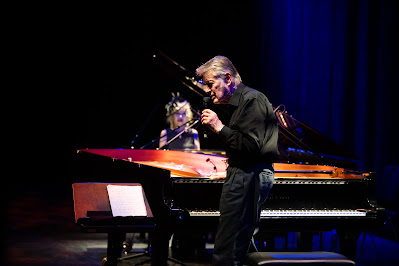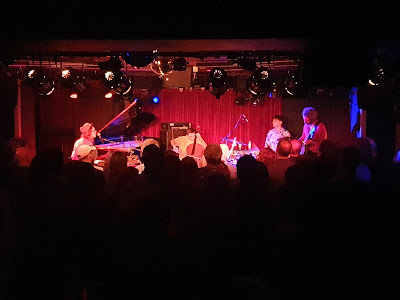By Paul Acquaro
It was the last day of the Jazzfest Berlin, a rainy Sunday morning, and I was decked out in rain gear and biking through glistening streets on the way to the Delphi Filmpalast am Zoo – a posh art-deco theater dating from 1927, and also home to the famous Quasimodo music club. As I was dodging the deepest puddles and thickest patches of wet leaves, I was thinking back on what – so far – had been quite a rich and sometimes demanding set of concerts already, and the exciting sets coming up this evening. Now, I was headed to see the premiere of a new documentary, Tastenarbeiter, on free jazz legend and pianist Alexander von Schlippenbach.
The movie was a delight and the theater was full. At two hours, the film allowed the story to unfold in a natural feeling, narratively loose way, letting the accomplishments and backstory of the pianist to be told through day-in-the-life encounters with old friends and collaborators like trumpeter Manfred Schoof and drummer Gunter “Baby” Sommer, as well as making music with his wife and pianist Aki Takasi and son Vincent Graf von Schlippenbach, an accomplished DJ, and preparing for the Globe Unity Orchestra concert at the Haus Der Kunst in 2021. The visit with Sommer at his residence in Radebul, near Dresden, provides a peek into the importance of Free Jazz in East Germany, and the filmmakers visit to the late FMP organizer Jost Gebers throws a light on the tumultuous backdrop of Free Jazz in West Berlin in the late 1960s. Schlippenbach himself shrugs off the political aspects, as we rather meet an artist focused on his art and how it touches everything around him.
THURSDAY, November 2
In fact, on the opening night of the festival at the Berliner Festspiele complex in a nicely appointed corner of Berlin’s Charlottenburg, Schlippenbach closed the night with a triumphant set with Takase. Throughout the hour, the two played solo and duo on facing grand pianos and at the same piano, utilizing their patented four-hands-on-one-keyboard approach they employed for Four Hands Piano Pieces on Trost Records this year). They began with a Takase piece entitled “Steinblock,” which aptly describes the highly syncopated tune. Forcefully delivered on facing grand pianos, the blocky chords and choppy motions were simultaneously minimalist and maxed out, quite an invigorating start to the set. A song by Schlippenbach followed, more fluid and melodic in nature and representative of the varied nature of the set. One could get a sense of how the pair work and inspire each other from their interactions upon the stage. Another high point of the set was Takase’s rendition of Carla Bley’s lovely ‘Ida Lupino,’ which she dedicated the recently departed composer. They brought their set to a close with “Bach Factory,” both at the same piano, Schlippenbach concentrating on the low end of the keyboard, while Takase handled the vibrant go-for-baroque melody. Responding to the vigorous applause, they played a take on an Bavarian folk song for an encore.
 |
| Apparitions (© Berliner Festspiele, Photo Camille Blake) |
If Schlippenbach represents one end of the jazz spectrum, namely members of the first generation of Free Jazz musicians in Europe, then a set earlier on the same night aimed to represent the newest generation, in which a group of over 30 school students, ages nine to twelve, sang, snapped, and reacted to the combination of free and composed music by French musicians saxophonist Antonin-Tri Hoang and pianist Romain Clerc-Renaud. The work, “Apparitions,” anchored by the quartet Novembre and augmented by a cello trio and a second jazz trio, who were at first set up outside the hall near the side doors, was an ambitious work that played with the space. Musically speaking, cut-and-paste like passages passed between the groups; physically speaking, midway through the performance the doors were opened to the foyer and the other trio could be heard playing; and with light, different combinations of the performers would appear like apparitions on the darkened stage, like Shakespearean ghosts. Then, there were the children who had been rehearsing throughout the week to provide a choir from the balconies and a choreographed parade though the hall. If it sounds like a lot to take in, then this paragraph is a success, and if the kids who participated develop an interest in free improvisation, then that is the real success.
 |
| Sylvie Courvoisier and guitarist Mary Halvorson (© Photo by Geert Vanderpoele) |
It was, however, the opening act of the festival, the duo of pianist Sylvie Courvoisier and guitarist Mary Halvorson, that set expectations the highest. Both, somewhere in the middle of their ever growing careers, are putting their stamp on the somewhat atypical piano and guitar duo. In 2021, they released Searching for the Disappeared Hour on Pyroclastic Records and for all intensive purposes, the hour in question seems to be found in quite capable hands. The duo began with gentle pickings from both instruments and then rolled into questioning chords and darting melodies. Halvorson, playing sneaky, warping lines buffeted Courvoisier’s own fleet fingerwork – and vice-versus. Throughout the set, a real sense of instant composition was apparent. The attention to the harmonic atmosphere and the artful spinning of suspense, wonder and resolution was a thrill.
The first night of the festival did not really end at the Berliner Festspielhalle, but rather Quasimodo, the music club down the road, with the intense work of French cellist Valentine Cecalddi’s Bonn Bonn Flamme. Featuring the Portugese guitarist Luis Lopes explosive fretwork, Fulco Ottervanger’s furiously melodic piano and keyboard work, and Étienne Ziemniak’s roiling drum work, Cecalddi’s group whipped up a set that seemed to walk a thin line between safety and danger. The group released their eponymous album this past summer on Clean Feed Records, which proved to be only a starting point for their live adventures. Wrapping intense feedback laden freakouts inside charmingly melodic tunes among other absurdities, the quartet remixed the history of jazz into a potent mix as they delighted they standing room only audience well into the night.
FRIDAY, November3
Jazzfest Berlin obviously stretches beyond the boundaries of the Berliner Festspiele grounds, to include the nearby jazz club A-Trane, the aforementioned Quasimodo, as well as the Wilhem-Kaiser-Gedachtness-Kirche, located at the busy intersection between Kurfürstendamm and the Bikini Mall. It also stretches the boundaries of what may even be considered jazz, even by the most expansive definitions.
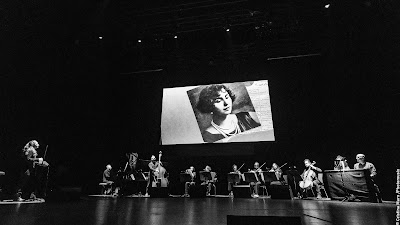 |
| Nancy Mounir: “Nozhet El Nofous” (© Photo by Cristina Marx/Photomusix) |
Egyptian multi-media artist Nancy Mounir’s “Nozhet El Nofous” is the result of several years of researching and exploring the micro-tonal music of female singers from 1920’s Egypt. Mostly forgotten by history, even when they were still alive, these singers were relegated out of the cultural space when in 1932 the Congress of Arabic Music in Cairo standardized tuning practices. Mounir presented the start of this work during the 2020 pandemic version of the festival with a video work, expanding it now to a concert with live narration. She developed the work by ‘rescuing’ the singers from fragile 78s and setting it to a contemporary octet featuring herself on the most microtonal of modern instruments, the theremin. Along with multimedia display of images of the singers from the period and narrations of interviews made during her research. Though conceptually compelling, the performance, however, felt like it lost momentum in the rather episodic presentation and subtle supporting compositions.
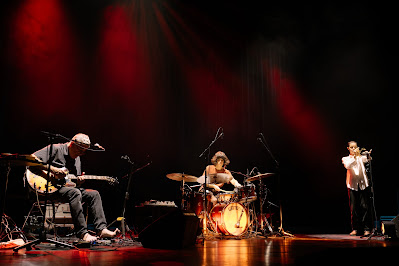 |
| Frith, Portugal, Santos Silva (© Berliner Festspiele, Photo Camille Blake) |
After a short break during which audience members could be overheard offering mixed opinions about the previous performance, the trio of guitarist Fred Frith, Susana Santos Silva and percussionist Maria Portugal took the main stage. Frith and Silva released Laying Demons to Rest on Rogue Arts last year and the album saw the two highly adventurous players engaged in an improvisation that drew on a vast source of extended techniques and unusual tones resulting in an impressively cohesive arcing 45 minute track. What they managed to create live, in the moment, with the addition of Portugal, was equally compelling. In addition to the comparative and contrasting musical dialog between Frith and Silva, Portugal lent her own subtle – and sometimes not so – percussive and vocal impressions.
Starting with a sputtering trumpet over the looped sound of Frith’s own breathing, they began the summoning. As Portugal added percussion, the sound of the trio did in fact feel like it was coming from a place beyond the stage. The sounds changed, Portugal began playing a large hand held cowbell and with a box that “mooed,” Frith conjured sounds from his guitar with a bow, and Silva’s trumpet rose brightly above the sounds. At the end of the set, the crowd erupted in applause – the demons once again successfully subdued.
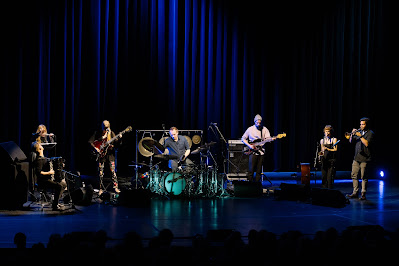 |
| Paal Nilsson-Love Circus (© Berliner Festspiele, Photo Camille Blake) |
The last set on the main stage was Norwegian drummer Paal Nilssen-Love’s Circus, which, true to its name, evokes a big-top like atmosphere with a kinetic and sometimes frenetic musical approach. The sextet, aside from Nilssen-Love’s commanding presence on drums, is comprised of strong musical personalities like trumpeter Thomas Johansson, saxophonist Signe Emmeluth, bassist Christian Meaas Svendsen, accordionist Kalle Moberg, guitarist Oddrun Lilja Jonsdottir, and the vocals and antics of South African singer and actress Juliana Venter. It’s Venter who is at the heart of the circus – she sings, speaks and acts out a jumble of song lyrics, texts and poetry, as well as dances and provides call and response scat singing with the other instruments. It actually sounds like it could be a bit enervating, no? Well, Nilssen-Love is a master of improvisation and the group he has assembled handles this potent mix with aplomb – the mix of sounds, words, and music swirled into a fantastic show that simply surged musically from the uptempo start to the pulse pounding end. All the musicians had a turn in the spotlight, with Johansson’s acrobatic horn playing often in focus. Emmeluth had absolutely stand out passages as well as Jonsdottir who had a rock-star moment, which in the current zeitgeist of guitars being textual instruments, hearing someone simply rock-out can be quite refreshing.
The past few years have seen a theme of “Chicago” permeating the festival. This year, a series of late night concerts dubbed “Sonic Dreams: Chicago,” was presented in an approximated “night club” in a transformed main and back stage area of the Festspielhalle.
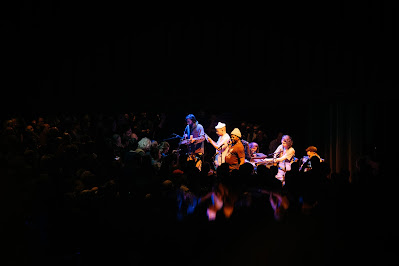 |
| Mike Reed’s The Separatist Party (© Berliner Festspiele, Photo Camille Blake) |
Drummer Mike Reed’s The Separatist Party, featuring the spoken word work of Marvin Tate and trumpet playing of Ben LaMar Gay, started out the night on a high note. Sounding often quite inline with their new eponymous release on We Jazz, the group delivered an impressive show to the throngs of concert goers filling the hall. The area was set-up with multiple low stage areas, which made for some interesting changes throughout the night, but was also somewhat frustrating, as many of the musicians were impossible to see unless one happened to be directly in front of them. Case in point, the off-the-program trio of Reed, bassist Joshua Abrams and saxophonist Ari Brown, drew the crowd across the room, delivered an exciting free(ish)-jazz set, but were essentially invisible. The set by the Bitchin Bahas, on a raised platform, was a bit better, though the synthesizer based music from keyboardist Cooper Crain, keyboardist Dan Quinlivan and saxophonist Rob Frye, provided less visual commotion.
The night drew to a close with the highly anticipated Natural Information Society, led by bassist – and here on gimbri (an African style bass) – Joshua Abrams. The group, in addition to the Chicago core of bass clarinetist Jason Stein (whose solo during the first jam was simply stellar), Ben LaMar Gay, drummer Mikel Avery, harmonium player Lisa Alvarado, and with Brown as a guest, enlisted several Berlin based musicians, saxophonists Anna Kaluza, Mia Dyberg and trumpeter Axel Doerner, to expand on the group’s long modal jams.
Read: Part 1 | Part 2


